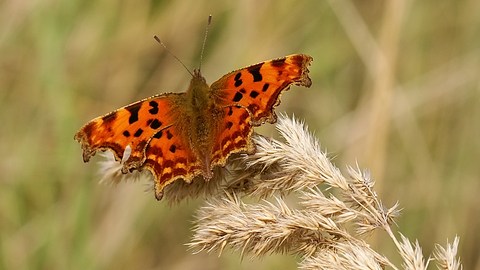
Comma ©David Longshaw
Comma
Scientific name: Polygonia c-album
The comma has distinctively ragged wing edges, which help to camouflage it - at rest, it looks just like a dead leaf! It prefers woodland edges, but can be spotted feeding on fallen fruit in gardens.
Top facts
Category
Stats
Wingspan: 5.0-6.4cmConservation status
Common.
When to see
January to DecemberAbout
The comma is a medium-sized orange-and-brown butterfly. It gets its name from the comma-shaped white spots on the underneath of its wings. It is on the wing throughout the year, having several broods and overwintering as an adult. It is a common and widespread butterfly of woodland edges, particularly during the spring and autumn. The caterpillars feed on common nettles, elms and willows.They have brown and white flecks that make them look like bird-droppings and help to camouflage them.
What to look for
The comma is unmistakeable: ragged, orange wings with brown spots distinguish it from similar species. Its underside has cryptic brown colouring, making it look like a dead leaf.Where to find
Found across England and Wales, and spreading into southern Scotland.Did you know?
Commas that emerge in early summer are much paler in colour than those that appear later on. This paler form will have a second brood, while the darker form overwinters as an adult.Watch
Comma caterpillar and butterfly © Tom Hibbert
